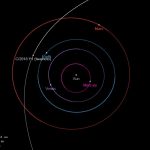
Comet C/2018 Y1 (Iwamoto) is seen at the bottom of this beautiful image by Rolando Ligustri. Used with permission.
A new celestial visitor – a comet – was discovered by Japanese astronomer Masayuki Iwamoto in late 2017. It’ll provide nice opportunities for astrophotographers, as it will pass close to a couple of Messier objects in February 2019. It’s a fast-moving comet that will be closest to Earth on February 12, 2019, at around 2:57 p.m. ET (19:57 UTC; translate to your time zone). The celestial visitor will safely pass by Earth at some 28 million miles (45 million km). The comet has been designated C/2018 Y1 (Iwamoto).
This comet is fast! Comet C/2018 Y1 (Iwamoto) is traveling through space at the amazing speed of 147,948 miles per hour (238,099 km/h) or 66 km per second, relative to Earth.
The best nights for observing the comet (with binoculars and small telescopes) should be on February 11 and 12. Preliminary estimates suggest the newly found comet might reach a brightness or magnitude between 7 and 7.8 , which means it should be easily seen with small telescopes and binoculars. It will not be visible to the eye alone.
During closest approach to Earth, comet Iwamoto will be located in front of the constellation Leo the Lion, which is visible late at night at this time of year.
Astrophotographers might be able to capture this comet passing close to some galaxies, as seen from our perspective. See the illustrations below:
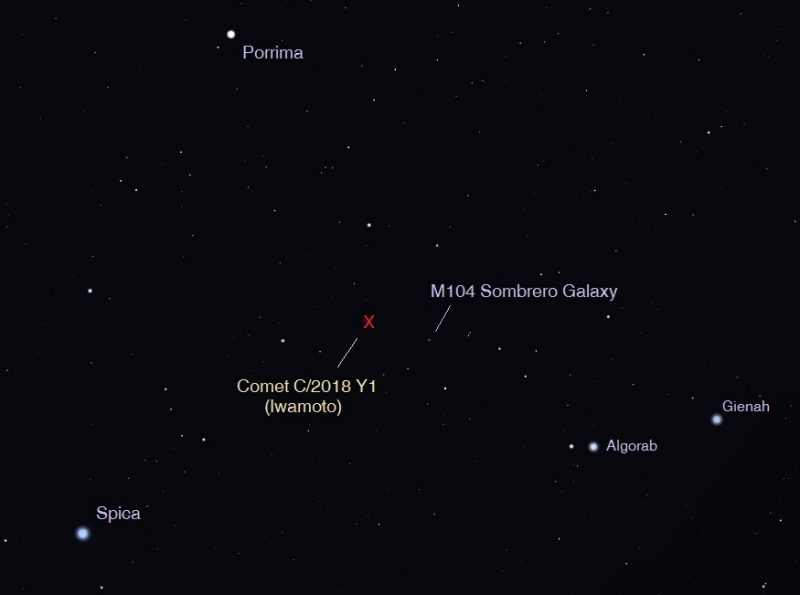
Late on the night of Saturday, February 2, 2019, Comet C/2018 Y1 (Iwamoto) passes close to M104 (Sombrero Galaxy), providing a nice opportunity to astrophotographers. Illustration by Eddie Irizarry using Stellarium.
On February 2, 2019, comet Iwamoto passes close to Messier 104 (Sombrero Galaxy), while by February 10, 2019, the celestial visitor will appear passing very close to Messier 95, a galaxy in the constellation Leo.
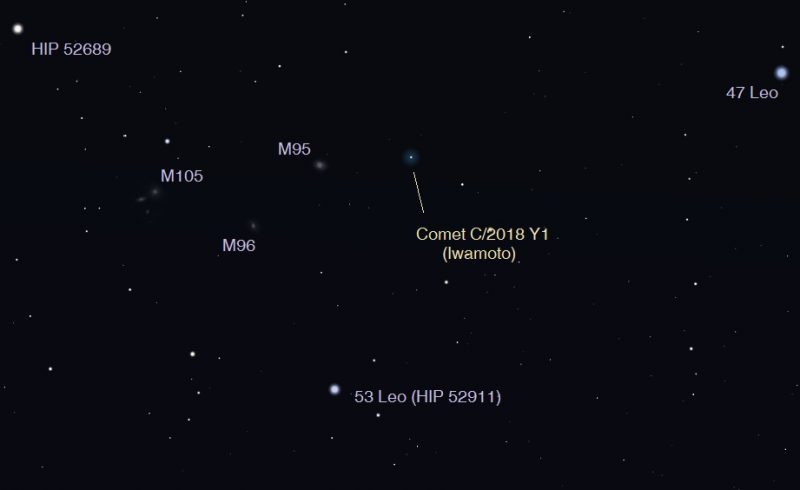
Facing east on February 10, 2019 at around 10 p.m. CT as seen from the central US. Comet C/2018 Y1 (Iwamoto) will pass close to some galaxies in Leo, especially Messier 95. Illustration by Eddie Irizarry using Stellarium.
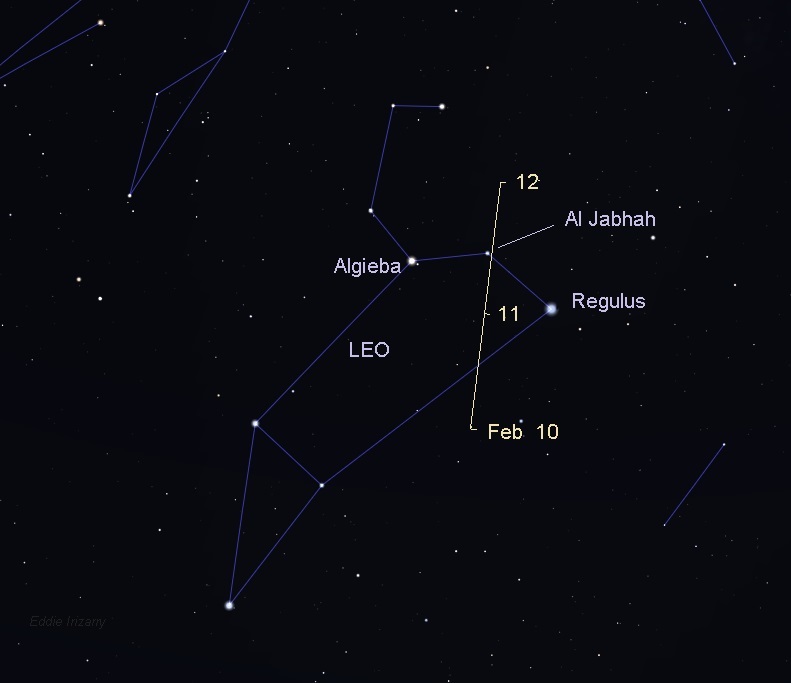
Location of comet C/2018 Y1 (Iwamoto) from February 10 to 12, 2019. Binoculars should provide a nice view of the fuzzy patch of light, while telescopes might allow seeing a hint of a green color. Facing east at 10 p.m. CT as seen from central U.S. Illustration by Eddie Irizarry using Stellarium.
The comet was detected in images taken on December 18, 2018.
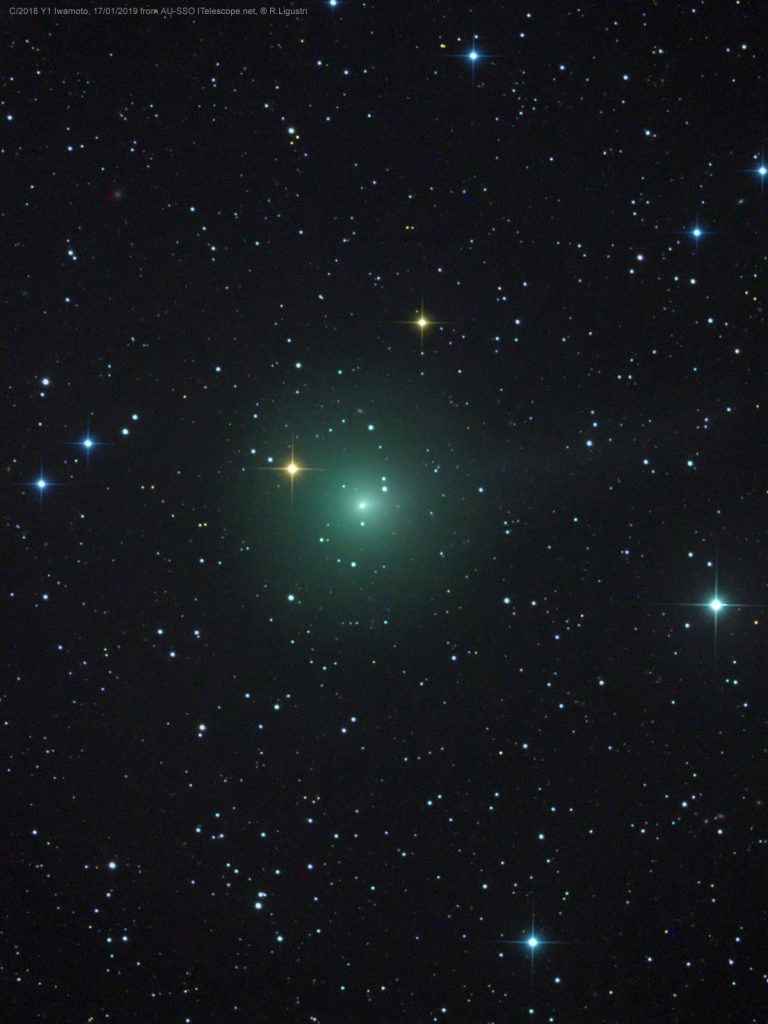
Comet C/2018 Y1 (Iwamoto) looks great in this image taken on January 17, 2019, by Rolando Ligustri.
We will keep you updated …
The orbit of comet C/2018 Y1 (Iwamoto) is very elliptical (elongated). Its orbit suggests this comet came from the Oort cloud of comets surrounding our solar system.
Bottom line: A new comet soon to be within reach of binoculars and small telescopes is heading toward a February 2019 encounter with the sun and Earth. It’ll pass Earth safely on February 11-12.
EarthSky lunar calendars are cool! They make great gifts. Order now. Going fast!
from EarthSky http://bit.ly/2Sn8mSb

Comet C/2018 Y1 (Iwamoto) is seen at the bottom of this beautiful image by Rolando Ligustri. Used with permission.
A new celestial visitor – a comet – was discovered by Japanese astronomer Masayuki Iwamoto in late 2017. It’ll provide nice opportunities for astrophotographers, as it will pass close to a couple of Messier objects in February 2019. It’s a fast-moving comet that will be closest to Earth on February 12, 2019, at around 2:57 p.m. ET (19:57 UTC; translate to your time zone). The celestial visitor will safely pass by Earth at some 28 million miles (45 million km). The comet has been designated C/2018 Y1 (Iwamoto).
This comet is fast! Comet C/2018 Y1 (Iwamoto) is traveling through space at the amazing speed of 147,948 miles per hour (238,099 km/h) or 66 km per second, relative to Earth.
The best nights for observing the comet (with binoculars and small telescopes) should be on February 11 and 12. Preliminary estimates suggest the newly found comet might reach a brightness or magnitude between 7 and 7.8 , which means it should be easily seen with small telescopes and binoculars. It will not be visible to the eye alone.
During closest approach to Earth, comet Iwamoto will be located in front of the constellation Leo the Lion, which is visible late at night at this time of year.
Astrophotographers might be able to capture this comet passing close to some galaxies, as seen from our perspective. See the illustrations below:

Late on the night of Saturday, February 2, 2019, Comet C/2018 Y1 (Iwamoto) passes close to M104 (Sombrero Galaxy), providing a nice opportunity to astrophotographers. Illustration by Eddie Irizarry using Stellarium.
On February 2, 2019, comet Iwamoto passes close to Messier 104 (Sombrero Galaxy), while by February 10, 2019, the celestial visitor will appear passing very close to Messier 95, a galaxy in the constellation Leo.

Facing east on February 10, 2019 at around 10 p.m. CT as seen from the central US. Comet C/2018 Y1 (Iwamoto) will pass close to some galaxies in Leo, especially Messier 95. Illustration by Eddie Irizarry using Stellarium.

Location of comet C/2018 Y1 (Iwamoto) from February 10 to 12, 2019. Binoculars should provide a nice view of the fuzzy patch of light, while telescopes might allow seeing a hint of a green color. Facing east at 10 p.m. CT as seen from central U.S. Illustration by Eddie Irizarry using Stellarium.
The comet was detected in images taken on December 18, 2018.

Comet C/2018 Y1 (Iwamoto) looks great in this image taken on January 17, 2019, by Rolando Ligustri.
We will keep you updated …
The orbit of comet C/2018 Y1 (Iwamoto) is very elliptical (elongated). Its orbit suggests this comet came from the Oort cloud of comets surrounding our solar system.
Bottom line: A new comet soon to be within reach of binoculars and small telescopes is heading toward a February 2019 encounter with the sun and Earth. It’ll pass Earth safely on February 11-12.
EarthSky lunar calendars are cool! They make great gifts. Order now. Going fast!
from EarthSky http://bit.ly/2Sn8mSb

Aucun commentaire:
Enregistrer un commentaire